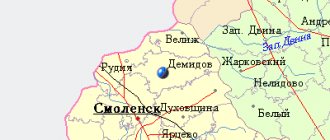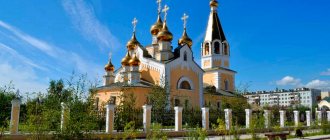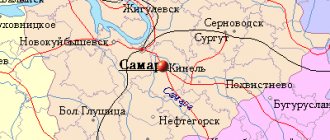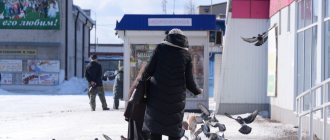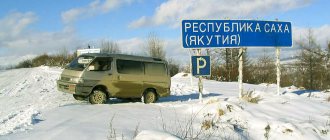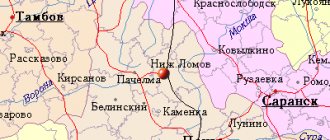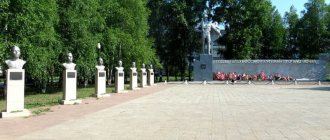Story
The settlement was founded in 1663 as a settlement of “industrial” people on the site of the Evenki camp Mukhtui (Mukhtukuevskaya village).
In the 18th century, the Yamsk postal station Mukhtuya was opened to serve the 2nd Kamchatka expedition of V. Bering.
In the 19th – early 20th centuries it was a place of political exile.
The rapid growth of the city began in the middle of the 20th century, and is associated with the discovery and development of diamond deposits in the Vilyuy basin. Since the village was the closest (230 km) settlement to the Mir kimberlite pipe, it became the “base” for the construction of the city of Mirny. In 1956, construction of a road began from Mukhtui to the future Mirny, and a river port began to be built. City status and a new name “Lensk” (from the name of the Lena River) were assigned in 1963.
Gallery
- 320 Lensk. Stele in honor of the pioneers.jpg
Embankment and stele in honor of the pioneers
- Error creating thumbnail: File not found
View of the embankment from the river
- Lensk2.jpg
City view
- Error creating thumbnail: File not found
Monument to coachmen (“Troika”) - one of the most beautiful places in the city
- 315 Lensk. Yagnysheva Boulevard.jpg
Boulevard named after Yagnyshev
- 332 Lensk. St. Lenina.jpg
Lenin Street
- 219 “Demyan Bedny” in Lensk at the pier.jpg
Marina
- Error creating thumbnail: File not found
Ice drift
Culture
The city has a branch of the Novosibirsk State University of Architecture and Civil Engineering and representative offices of: Novosibirsk State University of Economics and Management and Irkutsk State Technical University. There is a local history museum. It has 6 sections: ethnographic, flora and fauna, Russian life, Yakut hut, modern and numismatics. The city also has a music school and many dance groups.
In the art hall of the Central Library you can always see exhibitions of artists and photographers, both beginners and already famous ones, evenings and presentations are held. There is a literary association "Flamingo". Some Lenchan residents were even accepted into the Russian Writers' Union: Ivan Pereverzin, Nikolai Soin, Boris Lapardin and Sergei Moskvitin. Lensk is also rich in recognized artists: V. Stadnik, V. Kudrin, N. Kudrina, K. Kudrina, L. Tartyeva, V. Indeev, V. Balaev, G. Ineshin.
In 2007, the qualifying games for the First Futsal World Cup took place in Lensk.
Volleyball was well developed in Lensk until 2007; VC Alrosa was still playing in League B. Yuri Shustov (now coaching the youth team), Yuri Fedorenko, Alexander Klaus, Yuri Girich, Vladimir Yagnyshev made a very big contribution
In 2010, Lena volleyball players took 2nd place in the championship of the Republic of Sakha (Yakutia). Team composition: Vladimir Komkov, Nikita Vagin, Nikita Ivanov, Evgeny Pozur, Vladimir Mamontov, Konstantin Sobko, Sergey Kunichkin, Vladlen Zagornyak.
7 km southwest of the city there is a karst cave with a 25-meter waterfall and a karst lake.
Source
Economy
The leading sectors of the economy are river and road transportation. The diamond mining and joint-stock oil transport company Transneft have their divisions in Lensk.
The main enterprises of the city:
- forestry and woodworking industry enterprises[16];
- building materials plant;
- large-panel house-building plant;
- food enterprises;
- LLC GDK Lensk-Gaz Lenskoye LPUMG LLC Gazprom transgaz Tomsk OJSC Gazprom;
- Lenskoe RNU Transneft-Vostok LLC JSC AK Transneft.
Photo story about the city of Lensk
There are three albums with photographs of Lensk.
From above, Yakutia amazes with its beauty. I spent the entire flight at the window of an old but reliable AN-24. The plane covered the distance of 233 km from Mirny to Lensk in 50 minutes, whereas by car the journey would have taken 3 hours 30 minutes. The air ticket cost 5,000 rubles, which is 10 times more expensive than ground transport. The prices suited me. On the way back I took a minibus.
Lensk airport is quite small. It is one of 33 airports in Yakutia that are part of the Airports of the North enterprise. All photos of Lensk are here.
There are direct flights to Lensk from Yakutsk, Irkutsk, Talakan, and in the summer months from Krasnoyarsk and three times a week from Mirny. Flights are carried out by Avia, Angara, Polar Airlines, IrAero and Alrosa aircraft.
And it turned out that he was not the only one. The girl without a swimsuit, with whom I was flying here on the same plane, emerged from the water like a mermaid. A charming companion accompanied me on a walk along the embankment, which was built after the “Lena Flood” on May 16, 2001, when the city and nearby villages were completely submerged in water. Lensk was revived through the efforts of the entire country and, above all, through the efforts of the Lensk residents themselves.
We continue to walk along the Lensk embankment. It is luxurious with its view of the Lena and the other bank. But people often ruin everything. The five nine-story buildings were most likely built in the last century. Otherwise, I cannot understand why, in the age of high technology, such dull and mediocre houses would be built in a beautiful place. All windows have a partial view of the Lena. But the luckiest ones were the fire escapes, which got the best view in Yakutia.
In 1963, Mukhtu Ya was reorganized into the city of Lensk. Apparently, the Politburo did not like the name. It’s a pity that we are so fond of renaming everything. Why draw these lines, determining where history should begin and what can be forgotten. In Soviet school they told me that the First World War was an imperialist war. They drew a line dividing our history before 1917 and after. But what about the Russian people who laid down their lives for their Motherland or were they a different people? My Leningrad was named St. Petersburg. But this is a different case. The city was born again during the blockade from September 8, 1941 to January 27, 1944, and this is the hero city of Leningrad, and not the hero city of St. Petersburg. And Stalingrad? The appearance of his name on the map of the country will be the same holiday for me as the return of Crimea to Russia was.
Lenin looks directly at the granite and bronze monument on the banks of the Lena. The column with a boat on its top was erected in honor of the workers of the North. The boat represents all the pioneers, including the brave Russian navigators who were the first to sail across the northern seas and rivers to these lands.
Near the temple there is a stele and an eternal flame. Every Yakut city or village must have a monument in honor of the Defenders of the Fatherland who fell during the Great Patriotic War of 1941-1945. In Yakutia, 8 monuments to I.V. Stalin and their number is increasing. The Yakut people raised 25 heroes of the Soviet Union and 4 full holders of the Order of Glory.
Along the embankment we reach Lensk beach. The average temperature of the three summer months in Lensk is +21 ° C, but there are days much warmer. The city administration should declare such days as days off and go to the beach together with the residents of their city. There you can learn from them how people live and what concerns them.
And here is the city administration, but very far from the people, as if on a separate island.
These houses were built in 2001. It is clear that in the short summer it was necessary to quickly build houses for people. But will you be proud of such a house? The houses look gloomy and form a depressive area. And this is in the middle of such beautiful nature. Wooden houses in cold climates are, of course, an advantage. But in our century, it was possible to quickly build beautiful cottages and good roads with sidewalks for people? But what am I talking about? Thanks to Putin for this too.
I noticed that the houses are not on stilts, as in the more northern regions of Yakutia. Does this mean that there is no permafrost in Lensk? Write in the comments.
How can authorities, architects and builders respond to people’s demand to live in a beautiful modern home? Then why don’t they respond to their request to live in a beautiful modern city?
It's good to live. It’s also good to live in your own home. Many Lena residents do this. This is Pervomaiskaya street.
Greenery near the house and a flat, clean area where you can park your car anywhere create comfort. It's nice to approach your home.
People in Lensk love football. But mostly you don’t have to play, but watch TV broadcasts, and at night or early in the morning, due to the 6-hour time difference with Moscow.
I couldn’t help but put the Almazdortrans building on this page. Rare badges have also been issued in honor of the enterprise. It is the road workers from this organization who, since 1956, have been delivering goods from the port of Lensk to Mirny along the 233 km long road they themselves built. Then the cargo goes further north, where new diamond deposits are discovered.
It seemed to me that in Lensk all the kids go to kindergartens and there are enough places. I know that there are six secondary schools in the city, but please tell me how many kindergartens there are in the comments.
Source
Lensk what region or region
HISTORICAL REFERENCE
Lensk city
Lensk is the fifth largest city in the Republic of Sakha (Yakutia)
FROM MUKHTUI TO LENSK
The history of the city on the banks of the great Siberian river with the sonorous name Lensk goes back to ancient times. It was not possible to find the exact date of the founding of Mukhtui in archival documents, but reference to various historical evidence and narrowing the time frame indicate that 1743 should be taken as the starting point.
It was in that year that the representative of the Yakut voivodeship office, the manager of the Vitim-Peleduy settlements, the Pentecostal Cossack Zakhar Baishev, opening the Irkutsk-Yakutsk highway, established, starting from Yakutsk, 28 machines with a distance between them of 50-60 versts. He marked the machines according to the map of Lena, which Vitus Bering personally handed to him. The territory of the modern Lensky district had eight stations: Zherbinskaya, Chakhyyanskaya, Murinskaya, Khabalandinskaya, Khamrinskaya, Berezovskaya, Peskovskaya and Vitimskaya. The location of Mukhtui falls on one of these links, namely “Murinskaya station - Khabalandinskaya station.” Not all settlements established by Zakhar Baishev arose: the location of some of them was inconvenient for settlement due to steep banks, swamps, sands and lack of land. In particular, the Khabalandinskaya station (20 versts from Mukhtui up, along the right bank) and the Chakhyyanskaya station (between Soldykel and Batamai near Lake Chakhyyan) were “opened” only on paper. The road was paved, but it was populated very slowly, although there was traffic along it all year round. The winter route lasted from October to April, and the summer route opened in May.
It is easy to assume that it was the opening of the highway that breathed life into the place near the Chanchik and Mukhtuika rivers, which was more convenient for settlement and living than, say, the non-existent Khabalandinskaya station.
This version is confirmed by the list stored in the Russian State Archive of Ancient Acts “Descriptions of the Lena River from Verkholenskaya Otsrogu down this river to the city of Yakutsk” from 1736, which contains the following entry: “The end of the lower island of Chanchikov. The Chanchikova River, and in Yakut Moktuya Uryak , flowed into the Lena from the left side against the lower end of the aforementioned island, slightly below the mouth of this river; There are two log yurts on the left bank of the Lena, which were recently erected to contain the pit.” The important testimony of Gerhard Miller allows us to get as close as possible to the date of the formation of Mukhtui.
Two brand new log yurts in 1736 are not yet a village, especially since Zakhar Baishev himself ignored these two yurts when he marked the coachmen’s stations on the map. But history itself put everything in its place: in the Khabalandinsky machine tool he discovered only on paper, the station was never formed - it was too inconvenient for the coachmen to stop there in an empty place. They chose a more convenient place, where two yurts had already been cut down for the future “pit”. It was the tract that breathed life into the place near the Chanchikova River, and 1743 is the most obvious starting point in the history of Mukhtui-Lensk.
The first coachmen of the Mukhtuysk machine had log houses - something between a Russian hut and a Yakut yurt, large barns, a decent number of cows, horses and hayfields.
Mukhtuya peasants sowed barley and spring rye, winter rye, wheat and oats. When the Lena gold mines opened, they were engaged in transportation, delivering food and everything necessary to gold miners. The demand for hay, oats, and vegetables increased, which stimulated the rapid development of gardening and the expansion of hayfields. In the fall, with the establishment of the sleigh route, and until late spring, endless lines of horse-drawn carts walked along the Lena and Vitim. The peasant coachmen were so adapted to the carriage trade that 400-500 miles away, even in winter frosts, they managed to deliver fresh potatoes and cabbage from their gardens to the mines, carefully wrapping them in felt.
In 1862, a church was built in Mukhtuya, and a school was opened in 1869.
In 1887, the Vitim volost was disaggregated and the Mukhtui separate rural society (volost) was separated from it, which included the villages and stations: Konki, Tereshkino, Murya, Batamai, Soldykel, Nyuya, Turukta, Zherba, Tinnaya, Bechencha, Orto-Nakhara and other. So Mukhtuya became the center of the volost. Local authorities were appointed. The Mukhtuya volost administration began its activities on December 1, 1887, located in a new, beautiful house with carved platbands, built in 1882-1886.
Mukhtuya has seen a lot in her history, and a lot is stored in her memory. Pioneers, settlers and sovereign coachmen, postal chases to the sound of bells and bells, the first bread grown by the caring peasant hands of Russian peasants. Irkutsk and Moscow officials, governors and governors, priests and rogues, political exiles and beard-grown merchants. The first parishioners of the St. Nicholas Church, the melodic ringing of its five bells, quadrille during the “Lena Paris”, Russian writers Ivan Goncharov and Vladimir Korolenko. Pauzki and carbaz trucks loaded with expensive goods arrived at the fair; the first students at the desks of a one-class parish school... In her memory are the whistles of the first steamships on the Lena, revolutionary songs, the turmoil and confusion of modern times, the years of the imposition of Soviet power, collectivization and surplus appropriation, the hard times of the civil war, educational programs and universal education. The first screening of the film in the building of the people's house, the labor tension of the difficult war years, Khrushchev's corn, the inspiring enthusiasm of the diamond epic...
Lensk is 270. It has been a city for the last half century. Throughout history, people who were born, grew up or lived here for a long time have declared their love for Lensk. This is best evidenced by the number of poetic dedications to our city.
Our city has changed beyond recognition in half a century. On yellowed photographs of the sixties, Lensk is recognizable with great difficulty. It has ceased to be black and white, our Lensk. It is now bright, colorful, multicolored. Now this is a city where the interests of diamond miners and river workers, oil and gas workers, loggers and woodworkers are closely intertwined. About 25 thousand people live here.
Today, the city operates such large enterprises as the Almazdortrans management, a large oil depot that supplies the western region of the republic with petroleum products; OJSC "Surgutneftegaz", regional oil department of AK "Transneft", RPU "GazpromInvestVostok", LLC "Gazprom Dobycha Noyabrsk", OJSC "Taas-Yuryakh Neftegazodobycha" and many others.
Lensk has a great future. Lensk becomes one of the strategic cities of Yakutia. The name that was given to our city in Soviet times, “the gate of the diamond land,” is no longer relevant now. In connection with the development of the Talakanskoye oil field and the Chayandinskoye oil and gas condensate field, and the construction of the ESPO oil pipeline, the importance of our city for the republic has increased many times over.
The route of the federal highway to Ust-Kut has been approved, which will provide year-round communication between our republic and the western regions of the country. Preference was given to the republican option of passing the route through the territory of the Lensky district. After the transfer of the Mirny-Lensk highway into federal ownership and the construction of an 800-kilometer section of the future highway, one of the largest transport arteries in the east of the country will acquire logical completeness, rid us of winter roads and establish reliable communication from Yakutsk to Irkutsk and beyond.
The benefits of new economic relations are felt by all citizens. The issue of gasification of the city has been resolved. Housing construction is actively underway. Many private cafes and hotels appeared. Local firms act as subcontractors to large companies. All this suggests that well-paid jobs have appeared in Lensk, and therefore prospects for the townspeople.
People stopped leaving Lensk, as they did in the first years after the flood. The birth rate in our city has exceeded the death rate. Young specialists are arriving, and the implementation of megaprojects requires more and more workers. Life in Lensk is changing before our eyes. There was so much excitement during the Futsal World Cup in the summer of 2007! How many happy smiles are lit in Lensk by the traditional festival “Lena Spaces”, City Day, Youth Day. Life in Lensk is becoming more and more dynamic and interesting.
Sergey MOSKVITIN, journalist.
Source
History of Lensk
The first mention of the Evenki camp Mukhtui (from Evenki “Big Water”) dates back to 1663, when a settlement of “industrial” people arose here. The village began to be called Mukhtukuevskaya.
In the middle of the 18th century, the Irkutsk-Yakutsk postal route was opened. Lonely villages began to be populated by machine operators who were engaged in transportation and road maintenance. A Mukhtuya post station appeared in the village. From the moment of its inception, Mukhtuya was part of the Vitim volost of the Kirensky district of the Irkutsk province; subsequently it was under the jurisdiction of either the Yakutsk or Irkutsk provinces. Local residents were engaged in fur trading, farming, and carriage. In the XIX – early XX centuries. convicts convicted of political crimes served their exile here.
In 1922, Mukhtuya became part of the Yakut Autonomous Soviet Socialist Republic. During the years of the Civil War, the economy of the settlement fell into decay. At the end of the 1920s. collectivization began, marking the beginning of transformations in the village. In 1929, the Dvigatel collective farm was formed in Mukhtuya, and handicrafts developed. At the end of the 1930s. The first industrial enterprises appeared - timber industry enterprises, marinas, the Peleduy shipyard, a salt plant, and a steam mill.
On August 21, 1954, an expedition of the All-Union Geological Trust, consisting of a young geologist L. Popugaeva and a worker F. Belkin, discovered the first diamond deposit (kimberlite pipe) in the Vilyui River basin, not far from the modern city of Mirny. By 1955, 15 diamond deposits had been discovered in the Vilyuya basin. The village of Mukhtuya was the nearest settlement and in 1956 became a transshipment base for diamond miners. Construction began on a highway from Mukhtui to the future city of Mirny, as well as a river port. On January 4, 1957, the board of the USSR Ministry of Non-Ferrous Metallurgy adopted a resolution “On the industrial development of the Vilyui diamond deposits.” In just 2 years, from 1955 to 1957, the population of the village increased 5 times and reached 3 thousand people. Mukhtuya was given the status of a workers' village, and in 1963 the village was transformed into the city of Lensk (from the name of the Lena River).
In 2001, Lensk experienced a devastating flood, during which the water in the Lena rose 20 meters and covered the city. Damage from the natural disaster exceeded 6 billion rubles. About 10 thousand people came to the city to participate in repair and restoration work. Over the three summer months, more than 400 thousand square meters of housing were built.
Today, Lensk is still the “gateway” of the diamond region; oil and gas fields are also being developed here. Divisions of the world famous are located in Lensk. New microdistricts have been built in the city, the street has been landscaped. Embankment. Lensk exports oil, timber, furs, and is fully self-sufficient in potatoes and vegetables.
Transport
Water transport
A large port on the Lena River (delivery of goods for the diamond-bearing regions of Yakutia).
Air Transport
Airport "Lensk" of regional significance. The airport provides regular flights to the airports of the neighboring uluses of Yakutia, Yakutsk and Irkutsk.
Automobile transport
Lensk is connected by road with the city of Mirny.
Passenger transportation in Lensk is provided by Lenstranslogistik LLC. The largest volume of cargo transportation is provided by the Almazdortrans PU of AK ALROSA (OJSC) through its enterprises LATP-1 and LATP-2.
Source
Geography
The city is located on the left bank of the Lena River, on the Prilensky Plateau, 840 km from Yakutsk.
Climate
- Average annual air temperature - −5.4 °C
- Relative air humidity - 71.4%
- Average wind speed - 9.3 km/h
| Average daily air temperature in Lensk for the period 1980−2000[2]. | ||||||||||||
| Jan | Feb | Mar | Apr | May | Jun | Jul | Aug | Sep | Oct | But I | Dec | Year |
| −28.8 °C | −23.6 °C | −15.0 °C | −3.6 °C | 6.3 °C | 14.2 °C | 17.7 °C | 14.1 °C | 5.4 °C | −4.9 °C | −19.8 °C | −27.0 °C | −5.4 °C |
| Climate of Lensk | |||||||||||||
| Index | Jan. | Feb. | March | Apr. | May | June | July | Aug. | Sep. | Oct. | Nov. | Dec. | Year |
| Absolute maximum | −0,1 | 2,2 | 12,6 | 18,9 | 33,0 | 39,0 | 37,3 | 36,3 | 27,2 | 17,2 | 8,0 | 4,7 | 39,0 |
| Average maximum, °C | −25,3 | −20,3 | −8,4 | 2,2 | 11,6 | 21,1 | 23,9 | 20,1 | 11,1 | −1,5 | −15,6 | −24,1 | −0,9 |
| Average temperature, °C | −29 | −25,6 | −15,4 | −3,6 | 6,1 | 14,7 | 17,7 | 14,0 | 5,8 | −5,3 | −19,5 | −27,9 | −6,1 |
| Average minimum, °C | −34,1 | −32,2 | −24,3 | −11,9 | −1,1 | 6,7 | 10,0 | 7,1 | 0,3 | −10,2 | −24,9 | −32,8 | −12,7 |
| Absolute minimum, °C | −55,8 | −56,1 | −47,2 | −37,8 | −15 | −5,9 | −3 | −5,5 | −12,8 | −32,8 | −48,9 | −56,1 | −56,1 |
| Precipitation rate | 25 | 23 | 19 | 14 | 13 | 12 | 12 | 15 | 18 | 25 | 27 | 26 | 227 |
| Source: [climatebase.ru/station/24923/ Climate data archive] | |||||||||||||
LENSK ACTIVE
# [email protected] – news from Lensk and Lensky district
# [email protected] – poster of cultural and sporting events
# [email protected] – information for residents
LENSK ACTIVE post pinned
MBUK "CDNT" MO "City of Lensk" begins the autumn intellectual and entertainment holidays. Choose an event, call, make collective and individual requests.
We are waiting for all young and not so young residents and guests of the city.
Attention! All events are carried out in strict compliance with anti-epidemiological requirements!
LENSK ACTIVE post pinned
LENSK ACTIVE post pinned
Disinfection in apartment buildings resumes
At a meeting with the head of the city, Alexander Khorunov, with representatives of the city’s management companies and the passenger carrier MBU Granit, the issue of sanitary treatment of apartment buildings and in transport was discussed.
LENSK ACTIVE post pinned
MBUK "CDNT" MO "City of Lensk" invites charming mothers of the city of Lensk to take part in the correspondence city competition "Super Mom - 2021", dedicated to All-Russian Mother's Day. Applications for participation are accepted until November 5th. The number of applications is limited! Inquiries by phone: 4-30-15
Georgy Balykin pinned post
LENSK ACTIVE post pinned
Museum of Local Lore
LENSK ACTIVE post pinned
LENSK ORTHODOX
First age category from 9 to 12 years: Diploma of the 1st degree: Sofia Potapova, Municipal Budgetary Educational Institution “Secondary School No. 3 of Lensk”, head. Ovchinnikova L.V. Gavrish Ekaterina, fine arts studio “Draw-ka”, director. Rukavishnikova L.V. Second degree diploma: Sofia Babkova, Municipal Budgetary Educational Institution “Secondary School No. 3 in Lensk”, Babkova I.N. Urchik Alexandra, Municipal Budgetary Educational Institution “Secondary School No. 2 of Lensk”, Urchik I.Yu. III degree diploma: Ivan Kharchenko, MKU DO "SERGE", fine art studio "Aquarelle", Drobysheva S.V.
Second age category from 13 to 17 years: Diploma of the 1st degree: Meshcheryakova Aksinya, MKU DO "SERGE" "SYUN", head. Mikhailina E.Yu. Diploma of the 2nd degree: Olga Akimova, MKU DO "SERGE", fine art studio "Aquarelle", Drobysheva S.V. The remaining participants will receive certificates. Your victories are yet to come! We wish success to our winners in further qualifying rounds. And we will root and worry for them with all our souls and hearts! Department of Orthodox Culture
Notes
- ↑ 12
www.gks.ru/free_doc/doc_2016/bul_dr/mun_obr2016.rar Population of the Russian Federation by municipalities as of January 1, 2016 - [climatebase.ru/station/24923/80_00/ Climate data archive]
- ↑ 1234567891011121314
www.MojGorod.ru/r_saha/lensk/index.html People's encyclopedia “My City”. Lensk - [demoscope.ru/weekly/ssp/rus70_reg2.php All-Union Population Census of 1970 The size of the urban population of the RSFSR, its territorial units, urban settlements and urban areas by gender.] (Russian). Demoscope Weekly. Retrieved September 25, 2013. [www.webcitation.org/6GDOiMstp Archived from the original on April 28, 2013].
- [demoscope.ru/weekly/ssp/rus79_reg2.php All-Union Population Census of 1979 The size of the urban population of the RSFSR, its territorial units, urban settlements and urban areas by gender.] (Russian). Demoscope Weekly. Retrieved September 25, 2013. [www.webcitation.org/6GDOjhZ5L Archived from the original on April 28, 2013].
- [demoscope.ru/weekly/ssp/rus89_reg2.php All-Union Population Census of 1989. Urban population]. [www.webcitation.org/617x0o0Pa Archived from the original on August 22, 2011].
- [sakha.gks.ru/Lists/20101/Attachments/3/03_urban%20and%20rural%20population.xls The size of the urban and rural population of the Republic of Sakha (Yakutia)] (xls). Retrieved January 10, 2013. [www.webcitation.org/6E00BDnPV Archived from the original on January 28, 2013].
- [www.gks.ru/bgd/regl/B09_109/IssWWW.exe/Stg/d01/tabl-21-09.xls Number of permanent population of the Russian Federation by cities, urban-type settlements and districts as of January 1, 2009]. Retrieved January 2, 2014. [www.webcitation.org/6MJmu0z1u Archived from the original on January 2, 2014].
- [sakha.gks.ru/wps/wcm/connect/rosstat_ts/sakha/resources/4c22eb804e8ba4699a749f7904886701/01-05.xls All-Russian Population Census 2010. Yakutia. Tab. 5. Population by region, urban and rural settlements]. Retrieved April 5, 2016. [www.webcitation.org/6gY1ButF3 Archived from the original on April 5, 2016].
- [www.gks.ru/free_doc/doc_2012/bul_dr/mun_obr2012.rar Population of the Russian Federation by municipalities. Table 35. Estimated resident population as of January 1, 2012]. Retrieved May 31, 2014. [www.webcitation.org/6PyOWbdMc Archived from the original on May 31, 2014].
- [www.gks.ru/free_doc/doc_2013/bul_dr/mun_obr2013.rar Population of the Russian Federation by municipalities as of January 1, 2013. - M.: Federal State Statistics Service Rosstat, 2013. - 528 p. (Table 33. Population of urban districts, municipal districts, urban and rural settlements, urban settlements, rural settlements)]. Retrieved November 16, 2013. [www.webcitation.org/6LAdCWSxH Archived from the original on November 16, 2013].
- www.gks.ru/dbscripts/munst/munst98/DBInet.cgi?pl=8112027 Yakutia. Population estimate for January 1, 2009-2015
- [www.gks.ru/free_doc/doc_2015/bul_dr/mun_obr2015.rar Population of the Russian Federation by municipalities as of January 1, 2015]. Retrieved August 6, 2015. [www.webcitation.org/6aaNzOlFO Archived from the original on August 6, 2015].
- taking into account the cities of Crimea
- [www.gks.ru/free_doc/doc_2016/bul_dr/mun_obr2016.rar Population of the Russian Federation by municipalities as of January 1, 2016. Table “31. Population of cities and towns by federal districts and constituent entities of the Russian Federation as of January 1, 2016.” RAR archive (1.0 MB)]
- Corporate magazine of the RSHB “Rural Khozyain”
.
[www.bargzn.com/d/1070796/d/14-15_k.pdf Living near the forest means you won’t go hungry.], Rural Khozyain
(1.09.2015). - [www.udarnik-truda.ru/puteshestviya/msk-magadan-vladik-2009/msk-magadan-vladik-2009.htm Moscow - Magadan. Yakutsk, Kolyma, Vladivostok]
- [news.ykt.ru/article/7096 Yulia Farkhutdinova - the new “Top Model in Russian” - originally from Yakutia]
- [www.youtube.com/watch?v=H_jLt2bnoq4&list=PLEB941278AC28BA7E Video report]
